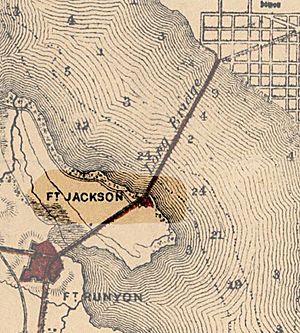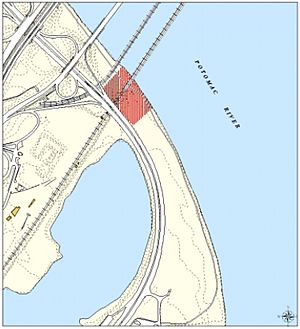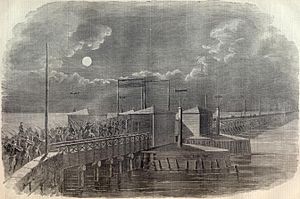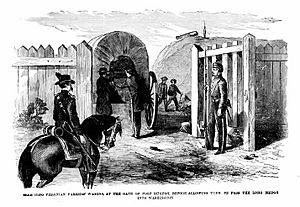Fort Jackson (Virginia) facts for kids
Quick facts for kids Fort Jackson |
|
|---|---|
| Part of the Civil War defenses of Washington, D.C. | |
| Arlington, Virginia | |

The Long Bridge and two of its guards, as seen from the Washington side of the Potomac River.
|
|
| Type | Timber fort |
| Site information | |
| Controlled by | Union Army |
| Condition | Dismantled |
| Site history | |
| Built | 1861 |
| Built by | U.S. Army Corps of Engineers |
| In use | 1861-1865 |
| Materials | Earth, timber |
| Demolished | 1865 |
| Battles/wars | American Civil War |
Fort Jackson was a small fort built during the American Civil War. It was located in Virginia, very close to Washington, D.C.. Its main job was to protect the southern end of the Long Bridge. This bridge was super important for the Union Army because it connected Washington, D.C., to Northern Virginia.
The fort was named after Jackson City. This was a busy area on the Virginia side of the bridge. Fort Jackson was built quickly in May 1861, right after the Union Army moved into Northern Virginia.
At first, the fort had four cannons to guard the bridge. But these were later moved to other forts. After 1862, Fort Jackson mostly had wooden walls called a palisade and dirt walls called earthworks. It only had small weapons for soldiers. In 1864, two cannons were brought back after a battle near Washington. A small group of Union soldiers stayed at the fort. Their job was to check everyone crossing the bridge. They also guarded it from anyone trying to damage it.
After the war ended in 1865, Fort Jackson was no longer needed. The wood from the fort was used for firewood or building. The dirt walls were flattened to make it easier to get to the Long Bridge. Today, you won't find any signs of the fort. However, the area where it stood is now part of Long Bridge Park in Arlington County. Experts think some old parts of the fort might still be buried there.
Contents
Why Was Arlington Occupied?
Before the Civil War, Alexandria County (now Arlington County) was mostly farmland. It was very close to Washington, D.C. This land used to be part of D.C. but was given back to Virginia in 1847. Most people lived in the city of Alexandria. The rest of the county had farms and a few houses. One famous house was Arlington House. It belonged to Mary Anna Custis Lee, whose husband was Robert E. Lee.
The Long Bridge connected this area to Washington. On the Virginia side of the bridge was Jackson City. This place was known for racetracks, gambling, and saloons.
After Fort Sumter was attacked in April 1861, President Abraham Lincoln said there was a rebellion. He asked for 75,000 soldiers to stop it. This made many Southern states angry. Virginia decided to vote on whether to leave the Union.
Union Army Moves In
General Joseph K. Mansfield was in charge of Union troops in Washington. He believed Northern Virginia should be taken over quickly. He worried the Confederate Army might put cannons on the hills of Arlington. They could then shoot at government buildings in Washington. He also wanted forts built on the Virginia side of the Potomac River. These forts would protect important bridges like the Chain Bridge and Long Bridge. His leaders agreed, but they waited for Virginia's vote.
On May 23, 1861, Virginia voted to leave the Union. That very night, Union Army troops started crossing the bridges into Virginia. The New York Herald newspaper described the march:
There can be no more complaints of inactivity of the government. The forward march movement into Virginia, indicated in my despatches last night, took place at the precise time this morning that I named, but in much more imposing and powerful numbers.
About ten o'clock last night four companies of picked men moved over the Long Bridge, as an advance guard. They were sent to reconnoitre, and if assailed were ordered to signal, when they would have been reinforced by a corps of regular infantry and a battery....
At twelve o'clock the infantry regiment, artillery and cavalry corps began to muster and assume marching order. As fast as the several regiments were ready they proceeded to the Long Bridge, those in Washington being directed to take that route.
The troops quartered at Georgetown, the Sixty-ninth, Fifth, Eighth and Twenty-eighth New York regiments, proceeded across what is known as the chain bridge, above the mouth of the Potomac Aqueduct, under the command of General McDowell. They took possession of the heights in that direction.
The imposing scene was at the Long Bridge, where the main body of the troops crossed. Eight thousand infantry, two regular cavalry companies and two sections of Sherman's artillery battalion, consisting of two batteries, were in line this side of the Long Bridge at two o'clock.
Most of the occupation was peaceful. But in Alexandria, a Union Colonel named Elmer E. Ellsworth was killed. He was trying to take down a Confederate flag from a hotel. The hotel owner shot him. Ellsworth was one of the first soldiers to die in the Civil War.
Building Fort Jackson

More than 13,000 soldiers marched into northern Virginia on May 25. They brought many tools like wheelbarrows and shovels. Engineers, led by John G. Barnard, started building forts and trenches along the Potomac River. Their goal was to protect the bridges. By the morning of May 24, work had already begun on Fort Runyon and Fort Corcoran. These were the first forts in the Civil War defenses of Washington.
Within a week, smaller forts were built to help. Fort Jackson was one of them. It was built near Fort Runyon, about 50 yards south of where the 14th Street Bridge is today. It had four cannons.
Fort Runyon was a very large fort meant to be the main defense for the Long Bridge. Fort Jackson was smaller. It was a guard post for soldiers to check people crossing the bridge. It also helped stop any Confederate spies who might try to destroy the bridge. About 200 soldiers were stationed there, including 60 who operated the cannons.
What Was Fort Jackson Used For?
On July 14, 1861, a group of soldiers from the 21st New York Volunteer Infantry was sent to Fort Jackson. They were later moved to another fort. We don't know which unit replaced them at Fort Jackson.
Later, a new line of forts called the Arlington Line was built. These forts were stronger and further away from Washington. Because of this, Forts Jackson and Runyon became less important. Fort Jackson was mainly used as a checkpoint for traffic on the Long Bridge.
Railroad and Repairs
In 1863, a new railroad bridge was built next to the Long Bridge. This was to help the Army of the Potomac move supplies in northern Virginia. The new bridge was part of the Orange and Alexandria Railroad. Because the bridge wasn't super strong, trains had to unhook their engines. Horses would then pull the train cars across the bridge.
To make space for the railroad tracks, parts of Fort Jackson's walls had to be removed. These were eventually replaced. But the big opening for the tracks made the fort weaker. In 1864, an officer named Barton S. Alexander wrote a report. He said Fort Jackson was falling apart:
The defense of the bridge is very imperfect, owing to the dilapidation and decay of Fort Jackson. The railroad cuts through the parapet and there are no gates except at turnpike entrance. The railroad crosses the ditch of the fort on a bridge which is not floored, but an enemy could soon cover it so as to make it passable. Cavalry could also ride around to the lower side of the fort and come in on the bridge.
To fix these problems, Alexander suggested adding more cannons and soldiers. He also wanted improvements to the fort itself. After the Confederate attack on Fort Stevens near Washington, some changes were made. The gates that were removed for the railroad were put back. General Christopher C. Augur suggested that Fort Jackson should have two light cannons during its repair.
After the War

After General Robert E. Lee's army surrendered in April 1865, Washington no longer needed strong defenses. Experts decided to close some forts, keep others ready, and completely abandon others. Fort Jackson was in the group to be completely abandoned. This was because it was no longer needed to inspect traffic or protect the bridge from spies.
The wood from Fort Jackson was either sold or taken by people living nearby. Many of these people were formerly enslaved people traveling north to start new lives. They likely used the wood for firewood or to build homes.
All the forts around or overlooking the city are dismantled, the guns taken out of them, the land resigned to its owners. Needy negro squatters, living around the forts, have built themselves shanties of the officers' quarters, pulled out the abatis for firewood, made cord wood or joists out of the log platforms for the guns, and sawed up the great flag-staffs into quilting poles or bedstead posts... The strolls out to these old forts are seedily picturesque. Freedmen, who exist by selling old horse-shoes and iron spikes, live with their squatter families where, of old, the army sutler kept the canteen; but the grass is drawing its parallels nearer and nearer the magazines. Some old clothes, a good deal of dirt, and forgotten graves, make now the local features of war."
By the early 1900s, the area where Fort Jackson stood was used for new bridges. A railroad bridge was built in 1903. Three years later, a road bridge was built nearby. There was also a brick factory that used clay from the old forts. All these projects erased almost all traces of Fort Jackson.
Today, a CSX Corporation railroad bridge runs through the site of Fort Jackson. The National Park Service is studying the Potomac shoreline nearby. They are looking for a possible spot for a boathouse. The northern part of Arlington County's Long Bridge Park might include some of the fort's original site. A study by the National Park Service found that historical items from Fort Jackson might still be buried there.
(See: Official Records of the War of the Rebellion)
See also
 In Spanish: Fort Jackson (Virginia) para niños
In Spanish: Fort Jackson (Virginia) para niños



